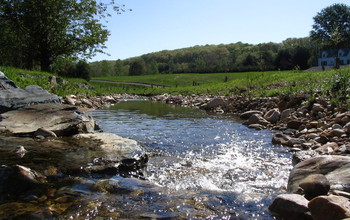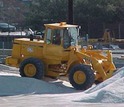 Credit and Larger Version |
September 10, 2014
The following is part sixteen in a series on the National Science Foundation's Long-Term Ecological Research (LTER) Network. Visit parts one, two, three, four, five, six, seven, eight, nine, ten, eleven, twelve, thirteen, fourteen, and fifteen.
Boston and Baltimore, San Juan and Tucson. What do they have in common?
The cities' ecosystems, especially their waterways, are all threatened by road salt, dissolved concrete, sewage overflows and algae blooms, say urban ecologists publishing a series of 14 papers this week in a special issue of the journal Biogeochemistry.
The issue is edited by University of Maryland geologist Sujay Kaushal and University of New Hampshire ecologists William McDowell and Wilfred Wollheim.
The studies were funded by the National Science Foundation (NSF), with much of the research conducted at NSF's Long-Term Ecological Research (LTER) sites in Baltimore, Md.; Plum Island, Mass.; and Luquillo, Puerto Rico, among others.
NSF's Critical Zone Observatory(CZO) Network, through the Luquillo CZO site, also supported the research.
"This synthesis brings the power of evolutionary biology to understanding ecosystem processes in urban environments, some of the most rapidly changing habitats globally," says Saran Twombly, NSF LTER program director.
"Merging evolutionary biology with ecosystem sciences is an exciting frontier for long-term ecological research, beginning with this issue on biogeochemical cycles."
Urban research from Boston to Baltimore, San Juan to Tucson
In the journal papers, scientists from across the United States review the effects of human actions on the geology, chemistry and biology of urban ecosystems.
Urban landscapes are more complex than they seem, but from coast to coast may work in surprisingly similar ways, says Kaushal.
"Urban ecosystems can change relatively quickly in response to human activities," he says. "These changes can result in rapid losses of ecosystem functions, like flood protection and pollution filtration--or can result in progress toward ecological health and productivity. The difference depends on how they are managed."
In an overview article, Kaushal, McDowell and Wollheim point out the factors that affect the evolution of urban ecosystems. For example, the streams, lakes and land surfaces that make up cities' watersheds show consistent patterns of change over time.
Waterways need a low-salt diet
Urban waters are becoming saltier, partly due to road salt used for de-icing, and partly because the salt people eat ends up in urban streams.
Excess salt in the human diet is excreted in human waste and captured by sewer systems. Crumbling sewage pipes leak this chloride-laden waste into groundwater, where it eventually mingles with surface water.
The researchers propose that one way to track the spread of urbanization is by looking at the chloride content of cities' freshwater rivers and streams.
Dissolved concrete: gone but not forgotten
City streams and rivers carry the chemical signature of dissolving concrete, a major building material in urban areas since the mid-20th century.
Most concrete contains cement made of powdered limestone, which weathers easily when exposed to acid rain or chemicals.
The scientists found that many cities now have their own human-made geology: concrete surfaces that mimic a type of limestone called karst.
This "urban karst" is constantly breaking down into its constituent elements, including calcium and carbonate minerals, which flow into urban streams and affect their pH, or acidity, and therefore their ability to sustain aquatic life.
Urban hotspots: sewage overflows, auto exhaust degrade rivers and streams
Urban ecosystems develop "hot spots," such as road crossings where automobile exhaust, litter, de-icing salt and other human-made substances may alter downstream water quality.
They also experience what the researchers call "hot moments," such as heavy rainstorms that wash large pulses of organic matter and manufactured chemicals into streams, or cause sewage overflows. These hot moments can suddenly change water chemistry in ways that shock natural systems.
Where does one watershed end and another begin?
The networks that supply cities with water--including storm drains, sewer pipes, roofs and gutters--evolve and expand over time, leaking groundwater and wastewater that humans bring into the area.
Boundaries between nearby cities' watersheds are blurring, making it hard to define, study and manage them.
Hope for the future
"There's a lot of good urban restoration work underway," says McDowell, "but often it only has a short-term effect, because urban watersheds follow their own evolutionary paths.
"For example, utility managers may build a stormwater retention pond to capture polluted runoff, such as excess nitrogen. And it may work very well for a few years. Then it fills in with sediment and becomes a wetland, and it's no longer functioning the way engineers designed it to work."
Adds Kaushal, "We hope scientists, managers and citizens will work together to make decisions that allow for what we call 'urban evolution'--that is, changes in the ecology of cities over time.
"If we do that, we can find effective ways to understand and manage urban ecosystems toward sustainability."
Copies of the 14 papers in the special issue are available free-of-charge for 30 days at the Biogeochemistry website.
| -- | Cheryl Dybas, NSF (703) 292-7734 cdybas@nsf.gov |
| -- | Heather Dewar, University of Maryland (301) 405-9267 hdewar@umd.edu |
NSF Grant: LTER-PIE: Interactions Between External Drivers, Humans and Ecosystems in Shaping Ecological Process in a Mosaic of Coastal Landscapes and Estuarine Seascapes: http://www.nsf.gov/awardsearch/showAward?AWD_ID=1238212&HistoricalAwards=false
NSF Grant: Luquillo CZO: The role of hot spots and hot moments in tropical landscape evolution and functioning of the critical zone:
http://www.nsf.gov/awardsearch/showAward?AWD_ID=1331841&HistoricalAwards=false
NSF Publication: Discoveries in Long-Term Ecological Research: http://www.nsf.gov/pubs/2013/nsf13083/nsf13083.pdf
NSF Publication: Where Life Meets Rock: Discoveries in the Critical Zone: http://www.nsf.gov/pubs/2013/nsf13112/nsf13112.pdf

Urban landscapes change with human activities such as creation of stormwater ponds.
Credit and Larger Version

A Maryland State Highway Administration loader moves salt stored for use in winter.
Credit and Larger Version

Aging sewer lines and erosion of stream banks contribute to water pollution in cities.
Credit and Larger Version

Algae blooms often occur in urban streams; excess nutrients lead to the blooms.
Credit and Larger Version

Extreme heat events affect urban ecosystems in cities such as Phoenix.
Credit and Larger Versión
the National Science Foundation (NSF),
Guillermo Gonzalo Sánchez Achutegui
ayabaca@gmail.com
ayabaca@hotmail.com
ayabaca@yahoo.com
Inscríbete en el Foro del blog y participa : A Vuelo De Un Quinde - El Foro!

No hay comentarios:
Publicar un comentario